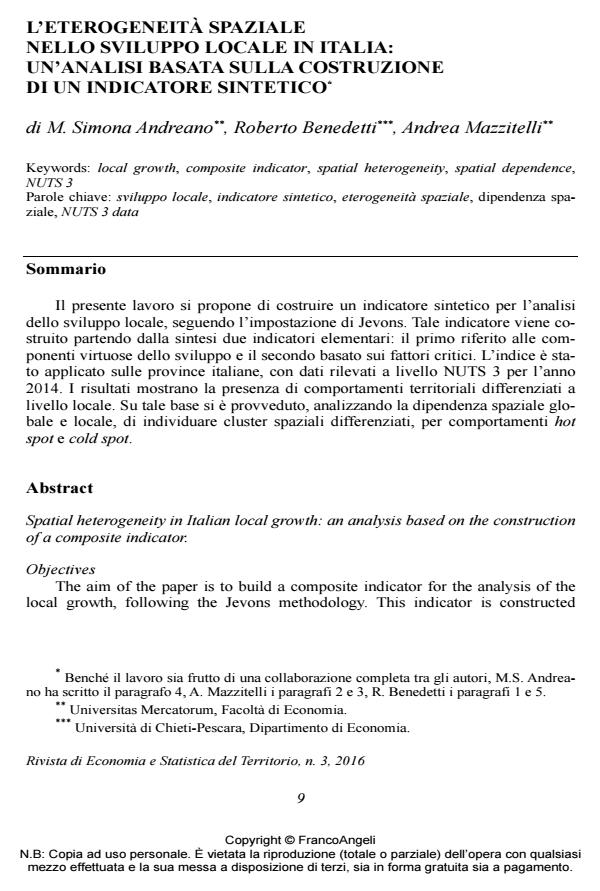Spatial heterogeneity in Italian local growth: an analysis based on the construction of a composite indicator
Journal title RIVISTA DI ECONOMIA E STATISTICA DEL TERRITORIO
Author/s M. Simona Andreano, Roberto Benedetti, Andrea Mazzitelli
Publishing Year 2017 Issue 2016/3
Language Italian Pages 19 P. 9-27 File size 361 KB
DOI 10.3280/REST2016-003002
DOI is like a bar code for intellectual property: to have more infomation
click here
Below, you can see the article first page
If you want to buy this article in PDF format, you can do it, following the instructions to buy download credits

FrancoAngeli is member of Publishers International Linking Association, Inc (PILA), a not-for-profit association which run the CrossRef service enabling links to and from online scholarly content.
Spatial heterogeneity in Italian local growth: an analysis based on the construction of a composite indicator.
The aim of the paper is to build a composite indicator for the analysis of the local growth, following the Jevons methodology. This indicator is constructed starting from two elementary indicators: the first refers to the virtuous components of the development and the second is based on its critical factors. The proposed indicator is applied on Italian NUT3 data and its spatial heterogeneity is analyzed.
Methods and Results.
The proposed composite indicator, to analyze the multidimensional phenomenon of the local growth, is based on the Jevons methodology. This technique uses the geometric mean to summarize the individual component information. In this way, unbalanced values will be automatically penalized. The spatial distribution of the indicator shows the presence of heterogeneous behavior of the Italian local growth. This heterogeneity is confirmed by the application of standard spatial analysis on the proposed indicator. .
Conclusions.
Empirical results show that Italian Provinces are characterized by socio-economic growth very different locally. Therefore, this complexity should be appropriately considered in the definition of local growth policies. North provinces evidenced hot spots behaviors, instead the South cold spots, where provinces with low values of the indicators are clustered together.
Keywords: Local growth, composite indicator, spatial heterogeneity, spatial dependence, NUTS 3
Jel codes: C01; C14; C21; C36; C52; O47.
M. Simona Andreano, Roberto Benedetti, Andrea Mazzitelli, L’eterogeneità spaziale nello sviluppo locale in Italia: un’analisi basata sulla costruzione di un indicatore sintetico in "RIVISTA DI ECONOMIA E STATISTICA DEL TERRITORIO" 3/2016, pp 9-27, DOI: 10.3280/REST2016-003002